SACRAMENTO, Calif. — California will begin allowing the reopening of schools, day camps, bars, gyms and some professional sports with modifications at the end of this week.
The state released new guidance for counties to follow to reopen a broad range of businesses that have been closed since mid-March to slow the spread of the coronavirus.
Schools and Childcare
The California Department of Public Health [CDPH] released interim guidance for schools and school-based programs to assist communities, school leaders, staff and parents to plan for the upcoming school year.
The following supplies will be distributed to meet the near-term needs of schools and childcare:
- No-touch thermometers for every school and childcare facility totaling over 47,000;
- Face shields for every teacher and childcare provider, totaling approximately 2.4 million;
- Over 14 million cloth face coverings for staff and students;
- Over 16 million disposable masks;
- 123,000 N95 masks for school-based health professionals, including those interacting with symptomatic students; and
- 143,000 gallons of hand sanitizer.
CDPH also released updated guidance for childcare programs and providers and published new guidance intended to help day camps formulate and implement plans for safe re-opening this summer.
Entertainment
Though some casinos in the Sacramento area have already reopened, California has released guidance on how to reopen casinos in sovereign tribal nations with reduced risk of transmission.
Similarly, music, TV and film production may resume in California, recommended no sooner than June 12, and subject to approval by the county public health officers. Employers are encouraged to continue work-from-home and teleworking practices, with workspace guidelines published by CDPH.
Professional sports in California may resume training and competition without live audiences. To reduce the risk of COVID-19 transmission, athletes, coaching staff, medical staff, broadcasting staff and others at sporting facilities or events should abide by COVID-19 protocols.
Stage 3 Reopening
The California Department of Public Health also released new guidance on how local jurisdictions with attestations to readiness should modify behavior and operations to reduce the risk of infection. All guidance is effective as of June 12 and should only be implemented with local health official approval.
Here is more information on when certain industries will reopen:
However, officials were still proactive in reminding Californians that reopening businesses does not mean the end of the COVID-19 pandemic.
"Just because some businesses are opening doesn't mean your risk for COVID-19 is gone. We all need to continue to keep physical distancing, wash our hands and wear face coverings in public," said Dr. Sonia Angell, State Public Health Officer and Director of CDPH.
The department published a County Monitoring List to give Californians insight into how their county is performing and provide an early indication of developing areas of concern. This will help county officials monitor the progress of Stage 3 reopening and can help them determine if necessary limitations or more general stay-at-home provisions need to be put in place due to potential outbreaks in the coming weeks.
Coronavirus by the numbers
Across California, most counties have seen an increase in coronavirus cases since the start of reopening, more testing availability, and the beginning of protests with little to no social distancing.
While the number of cases in the state has increased — seeing spikes higher than in months prior — the number of deaths has not had the same dramatic increase.
In the Sacramento region, the number of active cases has remained low for counties with fewer than 100,000 residents and the number. Meanwhile, the number of active cases continues to increase for counties like El Dorado, Placer Sacramento, San Joaquin and Stanislaus.
Sacramento regional map:
California map:
Coronavirus Background
According to the CDC, coronavirus (COVID-19) is a family of viruses that is spreadable from person to person. Coronavirus is believed to have been first detected in a seafood market in Wuhan, China, in December 2019. If someone is sick with coronavirus, the symptoms they may show include mild to severe respiratory illness, cough, and difficulty breathing.
Currently, there is no vaccine; however, the CDC suggests the following precautions, along with any other respiratory illness:
- Avoid close contact with people who are sick.
- Avoid touching your eyes, nose, and mouth.
- Stay home when you are sick.
- Cover your cough or sneeze with a tissue, then throw the tissue in the trash.
- Clean and disinfect frequently touched objects and surfaces using a regular household cleaning spray or wipe.
- Wash your hands with soap and water for a minimum of 20 seconds.
WHY HEALTH OFFICIALS ARE SO CONCERNED
Some people have compared the low overall death toll to the flu's high annual death toll in the United States as a reason not to be concerned about COVID-19, however, doctors and health officials are concerned for three main reasons:
- Some people have built up immunity to the flu, but few have immunity to the COVID-19 version of coronavirus.
- Both the flu and COVID-19 are spread by droplets, but COVID-19 might be spread in the air. Scientists are researching exactly how COVID-19 spreads.
- The CDC recommends wearing cloth face coverings in public where social distancing measures would be difficult to maintain, like at a grocery store or pharmacy.
LEARN MORE ABOUT THE STIMULUS PACKAGE:
FOR NEWS IN YOUR COMMUNITY, DOWNLOAD OUR APP:
►Stay In the Know! Sign up now for our Daily Blend Newsletter





